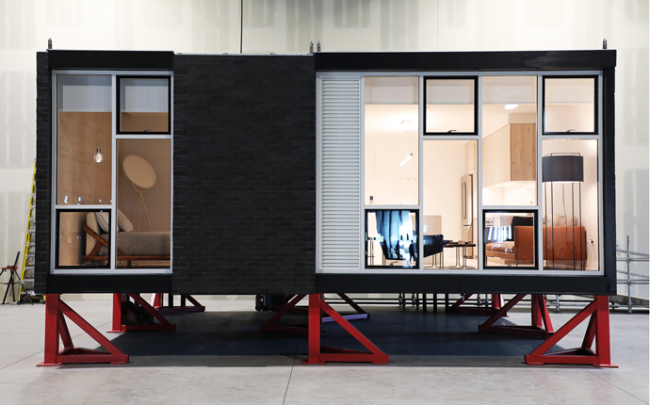For Skender, the future of homebuilding looks like a 680-square-foot apartment propped on stilts in the middle of a 130,000-square-foot warehouse.
The contractor showed off its prototype Monday for the one-bedroom unit it plans to produce en masse inside its factory on Chicago’s Southwest Side starting next year, representing the city’s first breakthrough in modular or “prefab” construction for multifamily buildings.
Developers around the country have considered the emerging building style, which involves assembling individual units at a centralized facility and then stacking them on building sites like Legos, as a way to save time and labor costs.
Skender announced its entrance into the space earlier this year with a 105,000-square-foot industrial lease in the Little Village neighborhood, where it plans to put more than 100 carpenters to work on an assembly line putting the units together. The company hired architect Tim Swanson to oversee the process through the role of chief design officer.

Skender’s prefab home prototype, a 680-square-foot one-bedroom apartment (Credit: Skender)
Skender is drawing up plans to build the modular units for a 10-story, 144-unit building in Uptown, as well as a seven-story, 122-unit building in Fulton Market. But the company has not revealed the address of either project, or named the developers it would be working with.
Skender is eyeing construction costs between $250 and $300 per square foot in each unit, but those aren’t the only numbers that matter to builders, Swanson said.
“We know we’ll get this done 40 percent faster than anyone else, and at a higher standard,” Swanson said inside the living room of the prototype apartment on Monday. “These boxes are being produced while the foundation is being dug, and then [creating] a 122-unit building is just six weeks of setting boxes.”
By April, the company plans to start pumping out ready-made rooms for three-flats, apartment mid-rises and medical offices. Studio apartments and patient rooms can be transported whole on wide-load trucks, but anything bigger will be broken into sections.
The company is focusing on three-flats as “a way to respond to both the affordable housing crisis and 25-foot vacant lots across the city,” Swanson said. The pre-made walk-up buildings would also make it easier for large-scale developers to build enough off-site affordable homes to satisfy the city’s Affordability Requirements Ordinance.
Skender’s prototype is a fully furnished, climate-controlled and electrified apartment, set inside a steel chassis and padded with insulation. Pipes snake along the outside, ready to fasten into its next home’s plumbing system.
Unlike Katerra, the California-based modular home start-up that raised $865 million from Softbank this year, Skender plans to build up to 95 percent of each unit — including plumbing and electrical fixtures — on the factory floor, according to CEO Mark Skender.
“We wanted to create flexible designs that can be built off those steel chassis, like you would at an automotive plant,” Skender said. “We can fit it out with different skins, windows, or mechanical systems, but it’s all still working through a supply chain where we can directly source all those materials.”
The contractor has built dozens of residential buildings, offices and hotels across the Midwest, including expanded offices this year for Sprout Social and HERE Technologies. Skender is also overseeing the construction of Sterling Bay’s 200-key Hyatt House hotel, which broke ground in Fulton Market earlier this year.
